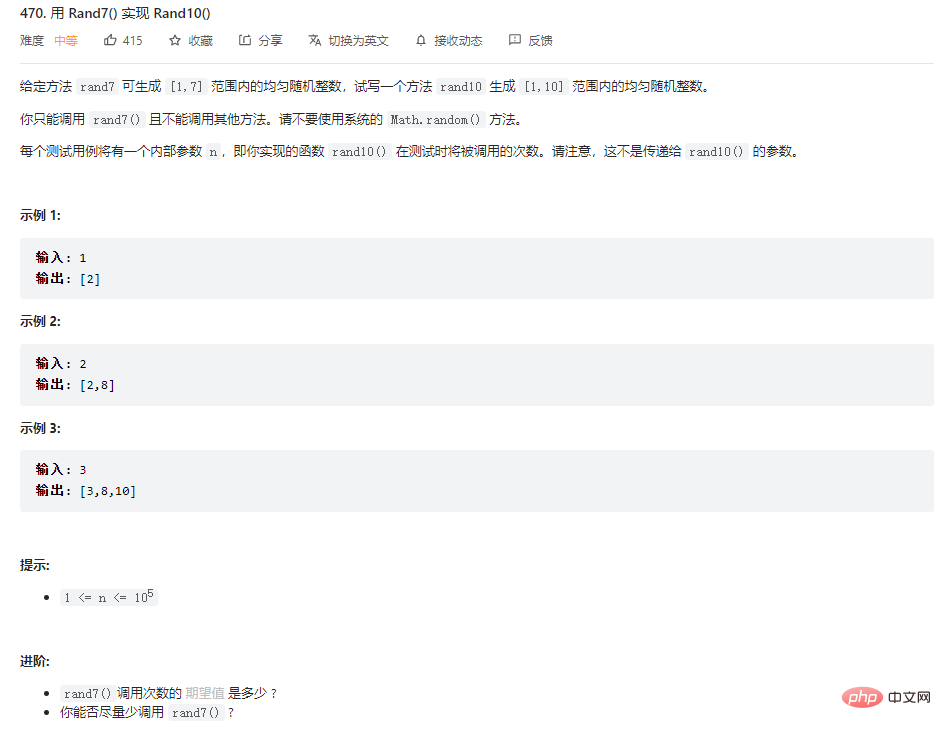Detailed explanation of examples of random function transformation in Java
This article brings you relevant knowledge about java, which mainly introduces the transformation of random functions in Java. The sample code in the article is explained in detail, which is helpful for us to learn Java. Those who are interested can learn more.

Recommended study: "java video tutorial"
solved problems
Question 1
In Java, the Math.random() function returns any decimal in the interval [0,1) with equal probability. That is, in the case of x < 1, the probability of the number in [0,x) appearing is x. If we want to change x < In the case of 1, the probability of the number in [0,x) is adjusted to x^2. What should be done?
Question 1 Idea
Since the probability of [0,x) is x, then call Math.random()# twice ##, if the larger value is also within the [0,x) interval, then both calls must be within the [0,x) interval (because any In [x,1), the return value will not be on [0,x)), that is, the probability is x^2, the code is as follows
package snippet;
public class Code_0004_RandToPow2 {
// 将`[0,x)`中的数出现的的概率调整成`x^2`
public static double randToPow2() {
return Math.max(Math.random(), Math.random());
}
}package snippet;
public class Code_0004_RandToPow2 {
// 将`[0,x)`中的数出现的的概率调整成`x^2`
public static double randToPow2() {
return Math.max(Math.random(), Math.random());
}
// 测试用例
public static void main(String[] args) {
int count = 0;
int testTimes = 10000000;
double x = 0.17;
for (int i = 0; i < testTimes; i++) {
if (randToPow2() < x) {
count++;
}
}
System.out.println((double) count / (double) testTimes);
System.out.println(Math.pow(x, 2));
}
}0.0288603Close to target requirements. Question 2 Suppose we have a random function0.028900000000000006
f(). This function can return one of [1,5] with equal probability. Number, how to only use the f() function without introducing other random functions to get a function that returns any number in [1,7] with equal probability g().
[1,7] with equal probability, if we can process a x() function, This function returns any number within the range of [0,6] with equal probability, then the target function g() only needs to call this x() function Adding 1, that is, the g() function requires
public static int g() {
return x() + 1;
}[0,6] and return a number with equal probability, we need to first To get a random function m() that returns 0 and 1 with equal probability, we can get it through the f() function, that is,
// 通过[0,5]等概率返回的随机函数f()
// 加工出等概率得到0和1
// 1,2,3,4,5 五个数
// 得到1,2的时候,返回0
// 得到4,5的时候,返回1
// 得到3的时候,弃而不用,再次尝试
public static int m() {
int ans = 0;
do {
ans = f();
} while (ans == 3);
return ans < 3 ? 0 : 1;
}m() that returns 0 and 1 with equal probability, we can easily generate a [0,6] method that returns a number with equal probability, because [ 0,6] requires three binary numbers to represent, then we can call the m() function three times, and we can get any number in the range of [0,7] with equal probability , we can retry the above process when we get 7, and only the result will be returned when [0,6], thus processing the x() function.
// 等概率返回0~6
public static int x() {
int ans = 0;
do {
ans = (m() << 2) + (m() << 1) + m();
} while (ans == 7);
return ans;
}f() can be obtained as follows
// 等概率返回1~7
public static int g() {
return x() + 1;
}package snippet;
public class Code_0005_Rand5ToRand7 {
// 此函数只能用,不能修改
// 等概率返回1~5
public static int f() {
return (int) (Math.random() * 5) + 1;
}
// 通过[0,5]等概率返回的随机函数f()
// 加工出等概率得到0和1
// 1,2,3,4,5 五个数
// 得到1,2的时候,返回0
// 得到4,5的时候,返回1
// 得到3的时候,弃而不用,再次尝试
public static int m() {
int ans = 0;
do {
ans = f();
} while (ans == 3);
return ans < 3 ? 0 : 1;
}
// 等概率返回0~6
public static int x() {
int ans = 0;
do {
ans = (m() << 2) + (m() << 1) + m();
} while (ans == 7);
return ans;
}
// 等概率返回1~7
public static int g() {
return x() + 1;
}
}
We must first implement a method that returns 0 and 1 with equal probability. Random function m(). , and then look at how many binary bits are needed in the target function interval to decide how many times to call the m() function. I won’t go into details. For the complete code, see
/**
* The rand7() API is already defined in the parent class SolBase.
* public int rand7();
* @return a random integer in the range 1 to 7
*/
class Solution extends SolBase {
public int rand10() {
return rand(10);
}
public int rand(int N) {
int bit = 1;
int base = 2;
while (base <= N) {
base = 2 << bit;
bit++;
}
int v = build(bit);
while (v < 1 || v > N) {
v = build(bit);
}
return v;
}
private int build(int bit) {
int v = 0;
for (int i = 0; i < bit; i++) {
v += (m() << i);
}
return v;
}
// 核心:生成 0 和 1 等概率返回的随机函数
public int m() {
int i = rand7();
while (i == 7) {
i = rand7();
}
return (i == 1 || i == 2 || i == 3) ? 0 : 1;
}
}f(), which returns 0 and 1 with unequal probability (but fixed probability). How to get equal probability of returning 0 and 1 only through the f() function? Random function g(),
f() function twice, you can get the following situation
0 0When both times are 0, or both times are 1, discard it, although 0 The probability is different from 1, but the probability of1 1
0 1
1 0
0 1must be the sameso we get1 0
0 1Return 0, get 1 0Return 1, that is, g()function
package snippet;
// 不等概率随机函数变成等概率随机函数
public class Code_0005_EqualProbabilityRandom {
// 不等概率函数,
// 内部内容不可见
public static int f() {
return Math.random() < 0.8 ? 0 : 1;
}
// 等概率返回0和1
public static int g() {
int first;
do {
first = f(); // 0 1
} while (first == f());
return first;
}
}java video tutorial》
The above is the detailed content of Detailed explanation of examples of random function transformation in Java. For more information, please follow other related articles on the PHP Chinese website!

Hot AI Tools

Undresser.AI Undress
AI-powered app for creating realistic nude photos

AI Clothes Remover
Online AI tool for removing clothes from photos.

Undress AI Tool
Undress images for free

Clothoff.io
AI clothes remover

Video Face Swap
Swap faces in any video effortlessly with our completely free AI face swap tool!

Hot Article

Hot Tools

Notepad++7.3.1
Easy-to-use and free code editor

SublimeText3 Chinese version
Chinese version, very easy to use

Zend Studio 13.0.1
Powerful PHP integrated development environment

Dreamweaver CS6
Visual web development tools

SublimeText3 Mac version
God-level code editing software (SublimeText3)

Hot Topics
 1662
1662
 14
14
 1419
1419
 52
52
 1311
1311
 25
25
 1261
1261
 29
29
 1234
1234
 24
24
 Break or return from Java 8 stream forEach?
Feb 07, 2025 pm 12:09 PM
Break or return from Java 8 stream forEach?
Feb 07, 2025 pm 12:09 PM
Java 8 introduces the Stream API, providing a powerful and expressive way to process data collections. However, a common question when using Stream is: How to break or return from a forEach operation? Traditional loops allow for early interruption or return, but Stream's forEach method does not directly support this method. This article will explain the reasons and explore alternative methods for implementing premature termination in Stream processing systems. Further reading: Java Stream API improvements Understand Stream forEach The forEach method is a terminal operation that performs one operation on each element in the Stream. Its design intention is
 PHP: A Key Language for Web Development
Apr 13, 2025 am 12:08 AM
PHP: A Key Language for Web Development
Apr 13, 2025 am 12:08 AM
PHP is a scripting language widely used on the server side, especially suitable for web development. 1.PHP can embed HTML, process HTTP requests and responses, and supports a variety of databases. 2.PHP is used to generate dynamic web content, process form data, access databases, etc., with strong community support and open source resources. 3. PHP is an interpreted language, and the execution process includes lexical analysis, grammatical analysis, compilation and execution. 4.PHP can be combined with MySQL for advanced applications such as user registration systems. 5. When debugging PHP, you can use functions such as error_reporting() and var_dump(). 6. Optimize PHP code to use caching mechanisms, optimize database queries and use built-in functions. 7
 PHP vs. Python: Understanding the Differences
Apr 11, 2025 am 12:15 AM
PHP vs. Python: Understanding the Differences
Apr 11, 2025 am 12:15 AM
PHP and Python each have their own advantages, and the choice should be based on project requirements. 1.PHP is suitable for web development, with simple syntax and high execution efficiency. 2. Python is suitable for data science and machine learning, with concise syntax and rich libraries.
 PHP vs. Other Languages: A Comparison
Apr 13, 2025 am 12:19 AM
PHP vs. Other Languages: A Comparison
Apr 13, 2025 am 12:19 AM
PHP is suitable for web development, especially in rapid development and processing dynamic content, but is not good at data science and enterprise-level applications. Compared with Python, PHP has more advantages in web development, but is not as good as Python in the field of data science; compared with Java, PHP performs worse in enterprise-level applications, but is more flexible in web development; compared with JavaScript, PHP is more concise in back-end development, but is not as good as JavaScript in front-end development.
 PHP vs. Python: Core Features and Functionality
Apr 13, 2025 am 12:16 AM
PHP vs. Python: Core Features and Functionality
Apr 13, 2025 am 12:16 AM
PHP and Python each have their own advantages and are suitable for different scenarios. 1.PHP is suitable for web development and provides built-in web servers and rich function libraries. 2. Python is suitable for data science and machine learning, with concise syntax and a powerful standard library. When choosing, it should be decided based on project requirements.
 Java Program to Find the Volume of Capsule
Feb 07, 2025 am 11:37 AM
Java Program to Find the Volume of Capsule
Feb 07, 2025 am 11:37 AM
Capsules are three-dimensional geometric figures, composed of a cylinder and a hemisphere at both ends. The volume of the capsule can be calculated by adding the volume of the cylinder and the volume of the hemisphere at both ends. This tutorial will discuss how to calculate the volume of a given capsule in Java using different methods. Capsule volume formula The formula for capsule volume is as follows: Capsule volume = Cylindrical volume Volume Two hemisphere volume in, r: The radius of the hemisphere. h: The height of the cylinder (excluding the hemisphere). Example 1 enter Radius = 5 units Height = 10 units Output Volume = 1570.8 cubic units explain Calculate volume using formula: Volume = π × r2 × h (4
 PHP's Impact: Web Development and Beyond
Apr 18, 2025 am 12:10 AM
PHP's Impact: Web Development and Beyond
Apr 18, 2025 am 12:10 AM
PHPhassignificantlyimpactedwebdevelopmentandextendsbeyondit.1)ItpowersmajorplatformslikeWordPressandexcelsindatabaseinteractions.2)PHP'sadaptabilityallowsittoscaleforlargeapplicationsusingframeworkslikeLaravel.3)Beyondweb,PHPisusedincommand-linescrip
 PHP: The Foundation of Many Websites
Apr 13, 2025 am 12:07 AM
PHP: The Foundation of Many Websites
Apr 13, 2025 am 12:07 AM
The reasons why PHP is the preferred technology stack for many websites include its ease of use, strong community support, and widespread use. 1) Easy to learn and use, suitable for beginners. 2) Have a huge developer community and rich resources. 3) Widely used in WordPress, Drupal and other platforms. 4) Integrate tightly with web servers to simplify development deployment.




